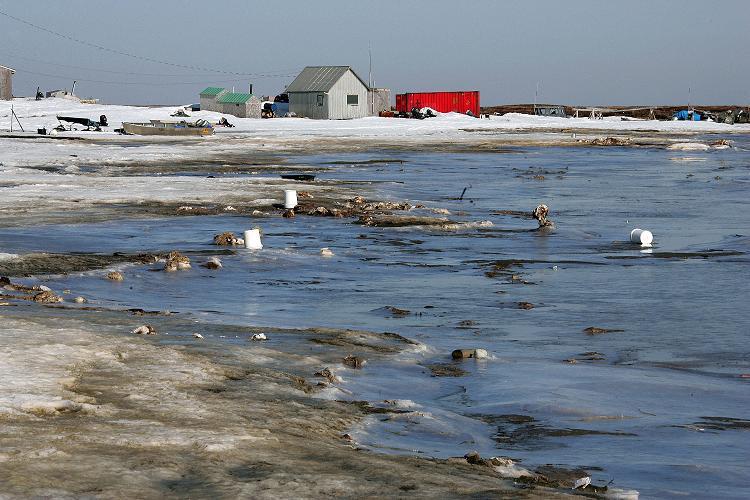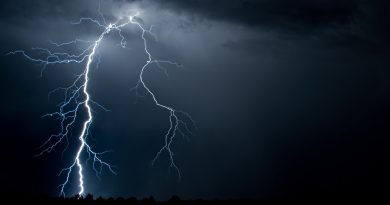Brookings: Federal funding, framework needed to help eroding Alaskan villages
 The lack of a federal program to address Alaska’s climate-imperiled villages leaves those communities facing further harm, says a paper released by the Brookings Institution that calls for modified disaster relief funding and other changes to help remote villages in harm’s way.
The lack of a federal program to address Alaska’s climate-imperiled villages leaves those communities facing further harm, says a paper released by the Brookings Institution that calls for modified disaster relief funding and other changes to help remote villages in harm’s way.
Those most endangered communities face a major dilemma: Little to no federal support is available for the enormously expensive task of moving a whole community. But at the same time, agencies won’t invest in villages with limited lifespans, says author Robin Bronen, an Anchorage human rights attorney.
That catch-22 is easily visible in the village of Newtok about 400 miles west of Anchorage, where fuel tanks are rotting away, power poles lean markedly and boardwalks traveling over spongy tundra are as wobbly as fun house walkways.
“It’s dangerous,” said tribal administrator Stanley Tom of life in Newtok, population 350.
Because of its precarious position along the shifting Ninglick River near the Bering Sea, the community long ago gave up any hope of receiving state and federal money to build a piped water and sewer system. Human waste is hauled in buckets to the river because the old lagoon vanished, posing health risks during flooding that have led to higher rates of respiratory illnesses than in other villages, Tom said.
“We requested a new lagoon, but the agency said no, you’re moving,” said Tom.
A head start
The village is ahead of others in relocating. It has cobbled some together state and federal resources to begin the process of building a new village at a site near the old one, with the state government and a domestic military program that provides manpower providing most of the help.
Currently six new homes and a barge landing site have been built at a Mertarvik. An emergency shelter is under construction. The relocation effort has received more than $1 million in federal grants, a small part of the total cost, Tom said.
“Not really federal money (that’s helped). It’s mostly been state money,” Tom said.
The report notes that a dozen villages are being displaced, and that four require complete relocation: Newtok, Shishmaref, Shaktoolik and Kivalina. The state declared a disaster in Kivalina last fall because flooding spread pollution from the landfill and curtailed the village’s water supply.
Past studies have determined that moving villages will costs tens of millions of dollars per community, or millions of dollars per villager, raising questions about who’s responsible for the costs.
The Brookings report notes that villages were established following a federal requirement established generations ago that Native children attend school. That led Alaska Natives to transition from a nomadic lifestyle following food sources to semi-permanent settlements along rivers and oceans accessible to barges that were necessary to resupply schools.
“Current federal disaster response legislation, the Stafford Act and its amendments, requires that funding be spent on repairing and rebuilding in the original location of the disaster,” Bronen writes. But that funding isn’t available to the most imperiled villages because state and federal government regulations that “prevent government expenditures on infrastructure built within flood plans.
Also, “no method exists to determine whether and when a community can no longer be protected in place with traditional flood control and erosion protection devices. This determination requires a sophisticated integrated social and environmental assessment in order to evaluate whether a community needs to relocate in its entirety to a new location, can gradually move some of the infrastructure and residents to a location close to the original community or can be protected in place.”
Bronen recommends that Congress change disaster relief laws so funding can be spent at new locations and that the federal government establish a framework to assist with community relocation if customary erosion and flood control efforts have lost their effectiveness.
The state, at least, has established programs that provide good first steps to help communities, including the Alaska Climate Change Impact Mitigation Program and the Coastal Impact Assistance Program, Bronen notes.
Related Links:
Alaska calls for greater national involvement in melting Arctic, Alaska Dispatch
Kivalina: An Arctic Alaskan village straddling 2 worlds, Alaska Dispatch
Contact Alex DeMarban at alex(at)alaskadispatch
For more stories from Alaska Dispatch, click here



